Thoughts on Generative Music - Part 3
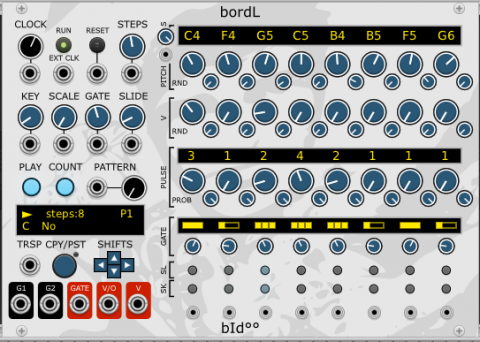
Thoughts on Generative Music - Part 3
(includes video) If you want to support my work, please make use of the "PayPal" button - thank you very much indeed!
I promised it in part 2. So here it is: a more detailed description of the generative software sequencer bordL in VCV Rack 2. This generative software piece of gear offers functions, which we find in hardware sequencers only at very high price ranges – and it offers it all for free – not to mention, that with “bridge” hardware modules like the ES-8 (Expert Sleepers) you can use bordL to sequence your hardware Eurorack modules too. https://youtu.be/L14Ckjp7GbU
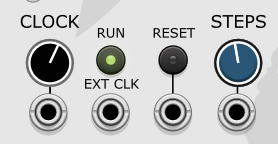
"bordL" can be externally clocked or can run using its internal clock, which can be CV modulated. There is a reset button and a step dial, both can be addressed by external CV. Even if there are only 8 pitch dials we can built 16 step sequences (see later in this article).
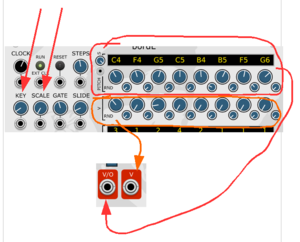
The upper 2 rows of potentiometers set the pitch (big knobs) and the randomness (small knobs) of each step. The term randomness concerns only the adjusted pitch (whether the step will produce the chosen pitch or another one), not the probability of producing a signal at all (skip or not skip this step). The pitch CVs are quantised to the chosen scale and the chosen root note. The root note of the scale is called “Key” and can be adjusted with the knob on the right of the GUI. Next to the “Key” knob there is the “Scale” knob. Both parameters can be modulated by external CV. The third and the fourth row of potentiometers also set the pitch (big knobs) and the randomness (small knobs), but they are not quantised at all. The tiny knob to the right of the row of quantised pitch potentiometers sets the so called “pitch sensitivity” of these quantised (and only of these quantised) potentiometers. Pitch sensitivity is more or less a compaction or expansion of the chosen scale. https://youtu.be/kK6y_V9IiZY
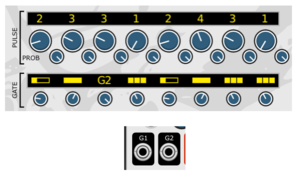 Each step can be played more than only once. The number of repetitions is set with the row of “Pulse” potentiometers and their randomness knobs. https://youtu.be/-4-x2srDyTw
Each step can be played more than only once. The number of repetitions is set with the row of “Pulse” potentiometers and their randomness knobs. https://youtu.be/-4-x2srDyTw
Below the “Pulse” rows there are the “Gate” switches. We can chose between 5 modes: with one LED lit only the first of the adjusted pulses of the step is played, during the rest of the pulses of this step there is silence. With all three LEDs lit all adjusted pulses of this step are played. And if an end-to-end bar is lit then only the first of the adjusted pulses is played, but it is played until the end of the last of the adjusted pulses of this step (no silence). Then there are the modes G1 and G2, which means, that this step depends on external gate signals fed in the jack called G1 and G2 in the left bottom corner of the GUI. https://youtu.be/BSv42878zlo
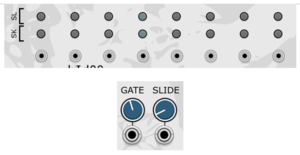
Then there are two rows of little buttons. The upper row attaches slide to the step. The length of the slide can be set by the “Slide” potentiometer in the left section of the GUI left to the “Gate” knob, which sets the length of the gate signals. Activating a button in the lower row makes the sequencer skip this step. Completely down at the bottom are the gate outputs of each individual step.
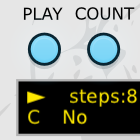 The “Play” button changes the direction the sequence is played back. The “count” button changes the internal count from “steps” to “pulses”. If this function is set to “pulses” I can increase the number of steps above 8 (“Steps” knob, see above). With the “Steps” knob set to 16 the sequence contains 16 of the adjusted pulses, no matter how many and which steps are included. Example: steps 1-4 are 1 pulse each, steps 5-7 are 2 pulses each, step 8 is 3 pulses. Together 13 pulses. The sequencer will play as follows: steps 1-8 (13 pulses), then steps 1-3 again. This way there are 16 pulses played. After playing steps 1, 2 and 3 this second time the sequence begins with step 1 again:
The “Play” button changes the direction the sequence is played back. The “count” button changes the internal count from “steps” to “pulses”. If this function is set to “pulses” I can increase the number of steps above 8 (“Steps” knob, see above). With the “Steps” knob set to 16 the sequence contains 16 of the adjusted pulses, no matter how many and which steps are included. Example: steps 1-4 are 1 pulse each, steps 5-7 are 2 pulses each, step 8 is 3 pulses. Together 13 pulses. The sequencer will play as follows: steps 1-8 (13 pulses), then steps 1-3 again. This way there are 16 pulses played. After playing steps 1, 2 and 3 this second time the sequence begins with step 1 again:
1-2-3-4-5-6-7-8-1-2-3 // 1-2-3-4-5-6-7-8-1-2-3 // ….. https://youtu.be/hMTnXVeF7b4
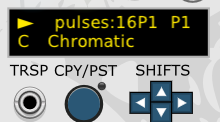
What´s left to say? Well, I can store up to 16 patterns, I can copy and paste one pattern into another, I can transpose the sequence up and down halftone per halftone, or shift the steps of the sequence left and right. The transpose function can be modulated by external CV.
All in all we can say, that the implemented functions together with the patch points to feed in external CV make bordL a very handy instrument to deal with randomness in generative patches, which lets us get deep insight in how generative music works. It´s also a very capable tool to learn about the matter of making generative music and to make our first own steps into this fascinating territory. Let me mention my ebook “A Systematic Introduction to Making Generating Music With Modular Synths” again (https://www.dev.rofilm-media.net/node/331), and say “good bye, see you in part 4”.
... to be continued
to part 1: https://www.dev.rofilm-media.net/node/335
to part 2: https://www.dev.rofilm-media.net/node/343
to part 4: https://www.dev.rofilm-media.net/node/358
to part 5: https://www.dev.rofilm-media.net/node/365
to part 6: https://www.dev.rofilm-media.net/node/374
to part 7: https://www.dev.rofilm-media.net/node/381
to part 8: https://www.dev.rofilm-media.net/node/386
to part 9: https://www.dev.rofilm-media.net/node/391
to part 10: https://www.dev.rofilm-media.net/node/404
to part 11: https://www.dev.rofilm-media.net/node/408
to part 12: https://www.dev.rofilm-media.net/node/415
to part 13: https://www.dev.rofilm-media.net/node/425
to part 14: https://www.dev.rofilm-media.net/node/427

Add new comment